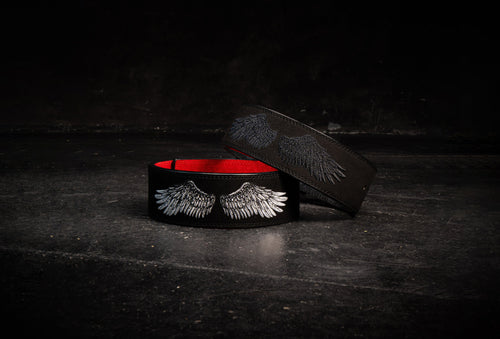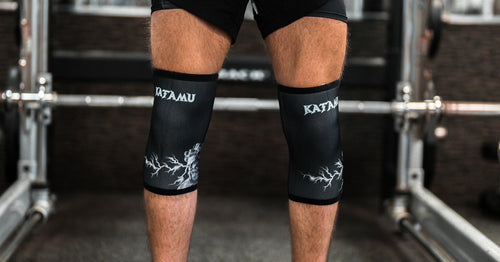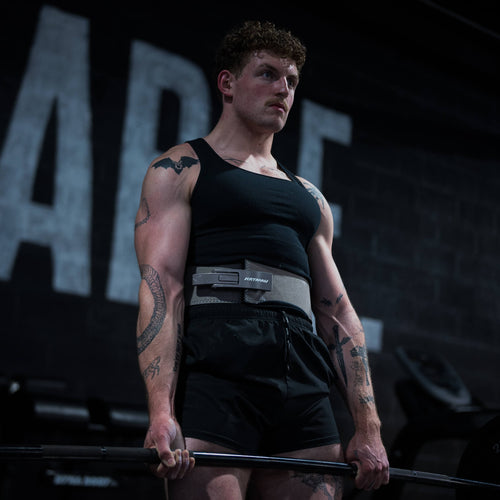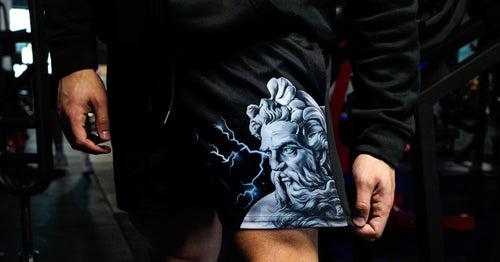Ready to unlock your full lifting potential in 2025? The right lever lifting belt can be your secret weapon for safer, stronger lifts and real results.
This expert guide will show you how to choose, fit, and master the lever lifting belt for fitness success. Discover the science behind belt support, get step-by-step fitting advice, and gain expert tips for every experience level.
Stay ahead with the latest trends and innovations for 2025. Take action now and lift with more confidence, power, and safety than ever before.
Understanding Lever Lifting Belts: What Sets Them Apart?
Curious about what makes a lever lifting belt stand out in the world of strength training? Whether you're a seasoned powerlifter or new to the gym, understanding the unique qualities of this essential gear can transform your lifting experience.
What Is a Lever Lifting Belt?
A lever lifting belt is a specialized weightlifting belt designed to provide maximum core support and stability during heavy lifts. Unlike traditional prong belts or velcro belts, the lever lifting belt uses a sturdy metal lever for quick and secure fastening. This mechanism allows lifters to achieve a consistently tight fit with minimal effort, making setup and removal much faster compared to other belt types.
Comparing Belt Types
Here's a quick look at how lever, prong, and velcro belts differ:
| Belt Type | Closure Mechanism | Adjustability | Speed of Use | Support Level | Typical Material |
|---|---|---|---|---|---|
| Lever Lifting Belt | Metal lever | Good (set holes) | Very fast | High | Leather/Suede |
| Prong Belt | Metal prongs | High | Moderate | High | Leather/Suede |
| Velcro Belt | Velcro strap | Very High | Fast | Moderate | Synthetic/Nylon |
Key Features and Materials
The lever mechanism is the signature feature of a lever lifting belt. It creates even pressure around your midsection, locking in core support for squats, deadlifts, and bench presses. The quick release design also means you can take the belt off instantly between sets, saving time and reducing hassle.
Most lever lifting belts are crafted from genuine leather or suede for durability and a firm feel. Some brands also offer synthetic options for those seeking vegan or budget-friendly choices. Thickness usually ranges from 10mm to 13mm, balancing rigidity with comfort.
Who Benefits from Lever Lifting Belts?
Powerlifters often rely on a lever lifting belt for maximum stability during one-rep max attempts. Bodybuilders use it to protect their lower back during heavy compound lifts. Even casual gym-goers can benefit from the added support, especially when progressing to heavier weights.
Safety and Injury Prevention
One of the main advantages of a lever lifting belt is its role in injury prevention. By increasing intra-abdominal pressure, the belt helps stabilize your spine, reducing the risk of lower back strains. This support is especially valuable when attempting personal bests or training with high intensity.
How Popular Are Lever Lifting Belts?
Recent studies show a steady rise in lever lifting belt usage among fitness enthusiasts. In fact, research on weightlifting belt usage patterns among gym members highlights both the motivations and common mistakes lifters make, such as using belts too frequently or for submaximal lifts. These findings underscore the importance of understanding when and how to use your belt for best results.
Common Myths and Misconceptions
Some believe that wearing a lever lifting belt weakens your core or makes you "cheat" during lifts. In reality, proper use encourages better bracing and can actually help you train your core more effectively. Another myth is that only elite athletes need a lever lifting belt, when in fact, lifters of all levels can benefit if they use it correctly.
Federation Regulations
If you plan to compete, it's important to note that most major federations like IPF and USAPL have specific requirements for lever lifting belts. Typically, belts must not exceed 13mm in thickness or 10cm in width, and they should be made from approved materials. Always check your federation's rules before purchasing a belt for competition.
In summary, the lever lifting belt stands out for its unique combination of support, convenience, and safety. Whether you're pushing for new records or just starting your strength journey, understanding what sets this belt apart helps you lift with confidence and protect your long-term health.

Choosing the Right Lever Lifting Belt in 2025: Key Factors to Consider
Choosing the ideal lever lifting belt in 2025 means balancing performance, comfort, and style. With so many options, understanding what truly matters can help you invest in a belt that supports your goals for years. Let’s break down the most important factors so you find the perfect fit for your training.
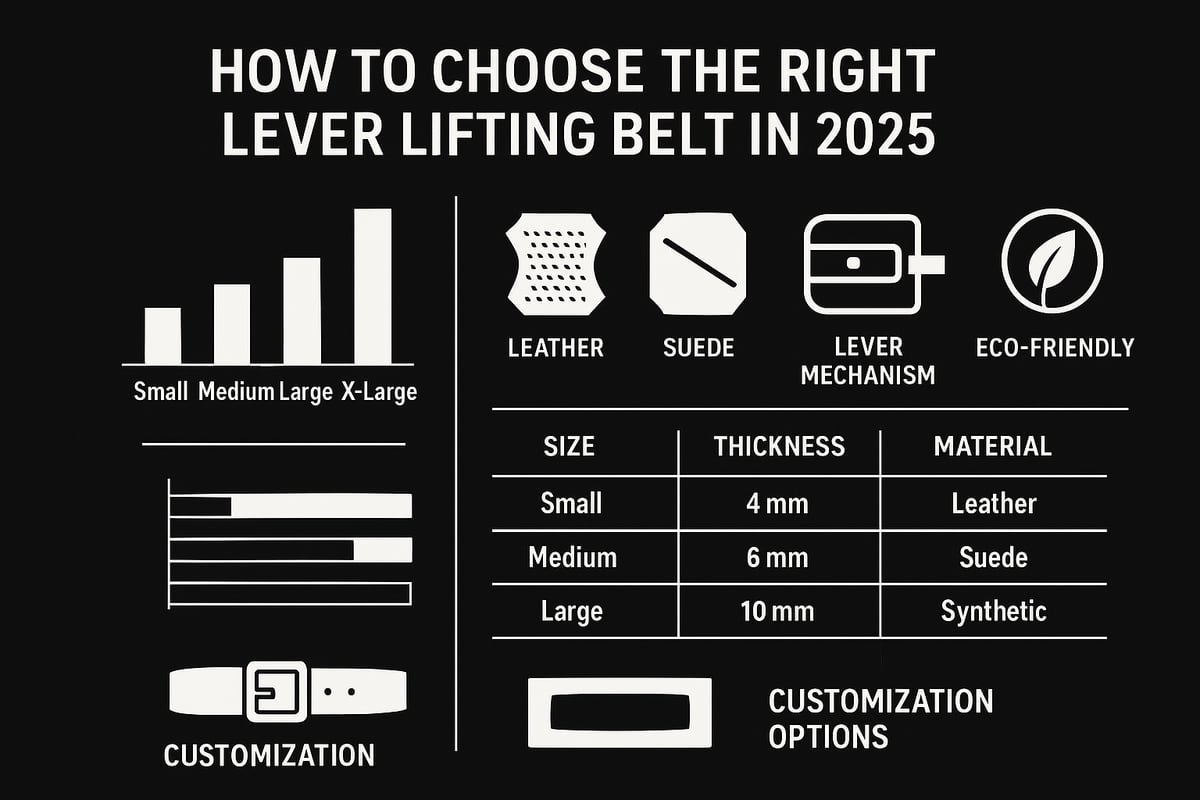
Sizing and Fit
The right size is the foundation of a safe and effective lever lifting belt. Always measure your waist at the level where the belt will sit, typically around the navel. Use a flexible tape, not your pants size, for accuracy.
Most brands offer detailed sizing charts. Look for belts with several adjustment holes or a lever mechanism that allows micro-adjustments. This ensures your lever lifting belt fits snugly, providing support without restricting movement.
Thickness and Width
Lever lifting belts come in various thicknesses and widths. The most common options are 10mm and 13mm for thickness, and 3-inch or 4-inch for width.
Here’s a quick comparison:
| Feature | 10mm Belt | 13mm Belt | 3-inch | 4-inch |
|---|---|---|---|---|
| Comfort | More flexible | Stiffer, more support | Great for smaller torsos | Standard for most lifters |
| Break-in | Faster | Slower | Less bulk | Maximum coverage |
| Use case | General, beginners | Advanced, heavy lifts | Deadlift focused | Squats, powerlifting |
A 10mm lever lifting belt is easier to break in and more comfortable for most lifters, while a 13mm belt offers maximum support for advanced powerlifting.
Material Quality
The material of your lever lifting belt impacts both performance and durability. Genuine leather belts are prized for longevity and support, while suede adds comfort and grip. Synthetic belts offer vegan and budget-friendly alternatives.
Look for double or triple stitching and a high-quality finish. A well-made lever lifting belt will last through years of lifts and still maintain its structure.
Lever Mechanism
The lever mechanism is the signature feature of a lever lifting belt. It allows for quick tightening and easy release between sets, saving time and effort.
Some mechanisms are removable and replaceable, letting you adjust the tightness without tools. Check if the lever is made from sturdy metal and if replacement parts are available. A robust lever lifting belt mechanism ensures consistent performance and safety.
Style and Aesthetics
Modern lifters want their gear to look as good as it performs. Many brands now offer customization options, from color choices to personalized embroidery and limited edition prints.
Consider if you prefer a classic look or want your lever lifting belt to stand out. Popular colors for 2025 include bold neons, matte blacks, and metallic finishes. Unique styles can boost motivation and help you express your personality in the gym.
Price, Brand, and Warranty
Lever lifting belts range from entry-level to premium. Entry belts may start around $50, while top-tier options can exceed $200. When comparing, factor in material quality, lever durability, and included warranties.
Choose a reputable brand that stands behind its products. For example, Premium Lever Lifting Belts are known for their high-grade materials, wide sizing range, and strong warranties, making them a favorite among serious lifters.
Trends for 2025
The lever lifting belt market is evolving rapidly. New trends include:
- Eco-friendly materials, such as vegan leather and recycled components
- Smart belts with built-in sensors to track performance and pressure
- Custom 3D-printed designs for a unique fit
- Enhanced antimicrobial linings for hygiene
- Limited edition drops and collaborations with top athletes
Stay ahead by seeking belts that blend technology, sustainability, and style.
Final Thoughts
Selecting the right lever lifting belt is an investment in your lifting journey. Focus on fit, quality, and features that match your goals. By weighing these factors, you’ll unlock safer, stronger lifts and stand out in the gym for years to come.
Step-by-Step Guide: How to Properly Fit and Use a Lever Lifting Belt
Unlock the full power of your lever lifting belt by mastering each step of fitting and use. Whether you are a beginner or a seasoned lifter, following the right process ensures you get maximum support, safety, and performance every time you train.

Step 1: Measure Your Waist for a Perfect Fit
Start by standing upright and using a flexible tape measure to find the circumference around your core, just above the belly button. This measurement is crucial for ordering the correct size lever lifting belt. Avoid sucking in or pushing out your stomach, as the goal is to get your natural waist size. Most sizing charts are based on this measurement, so double-check before purchasing.
Step 2: Adjust the Lever Mechanism
Once your lever lifting belt arrives, use a screwdriver to attach the lever to the belt at the appropriate holes for your waist size. The fit should be snug but not painfully tight. When fastened, you should be able to fit two fingers between the belt and your torso. If you lose or gain weight, readjust the lever position to maintain optimal support.
Step 3: Position the Belt for Each Lift
Proper placement changes depending on your exercise. For squats, position the lever lifting belt slightly above the hip bones, ensuring it covers the lower back and core. For deadlifts, wear it a bit higher or lower based on comfort and torso length. For the bench press, loosen the belt or shift it to allow proper arching and breathing. Experiment to find the spot that maximizes support without restricting movement.
Step 4: Secure and Release the Lever Safely
To fasten, hook the lever into the catch and snap it closed. The lever mechanism allows for quick, consistent tightness every time you lift. After completing your set, release the lever gently to avoid sudden pressure changes. Always check that the lever is fully engaged before lifting to prevent accidental opening.
Step 5: Master Breathing and Bracing Techniques
The main advantage of a lever lifting belt is its ability to help you create intra-abdominal pressure. Before a lift, take a deep breath into your belly (not just your chest), brace your core, and push out against the belt. This stabilizes your spine and reduces injury risk. Practice this breathing pattern during warm-ups to build muscle memory.
Step 6: Know When to Wear the Belt
Use your lever lifting belt for heavy work sets, max attempts, or when performing compound lifts like squats and deadlifts. Training beltless on lighter sets can help strengthen your core, so do not rely on the belt for every exercise. Listen to your body and use the belt as a tool, not a crutch.
Step 7: Maintenance and Care
To get the most out of your lever lifting belt, wipe it down after use, store it flat or hung up, and check for signs of wear around the lever and stitching. Tighten screws periodically and avoid leaving the belt in hot or damp environments. With proper care, a quality belt will last for years.
Common Mistakes to Avoid
- Over-tightening, which can restrict breathing and reduce performance.
- Placing the belt too high or low, leading to discomfort or poor support.
- Neglecting core training, which is essential even with belt use.
Real-World Tips from Athletes and Coaches
Top lifters recommend breaking in your lever lifting belt gradually. Wear it for short periods at first, then increase usage as it molds to your body. Many coaches highlight the importance of bracing technique, not just belt tightness. According to a recent Influence of Weightlifting Belts on Deadlift Performance study, proper belt use can improve deadlift mechanics and reduce perceived exertion, especially when paired with correct form.
Putting It All Together
A lever lifting belt is a valuable investment for serious lifters, but only if you use it correctly. By following these steps, you set yourself up for safer, stronger lifts and long-term progress. Remember, the belt is a tool to enhance—not replace—solid technique and consistent training.
Expert Tips for Maximizing Your Lifting Success with a Lever Belt
Unlocking the full potential of your lever lifting belt requires more than just wearing it during heavy lifts. Small adjustments, smart programming, and intentional accessory work can make a world of difference for your strength and safety.
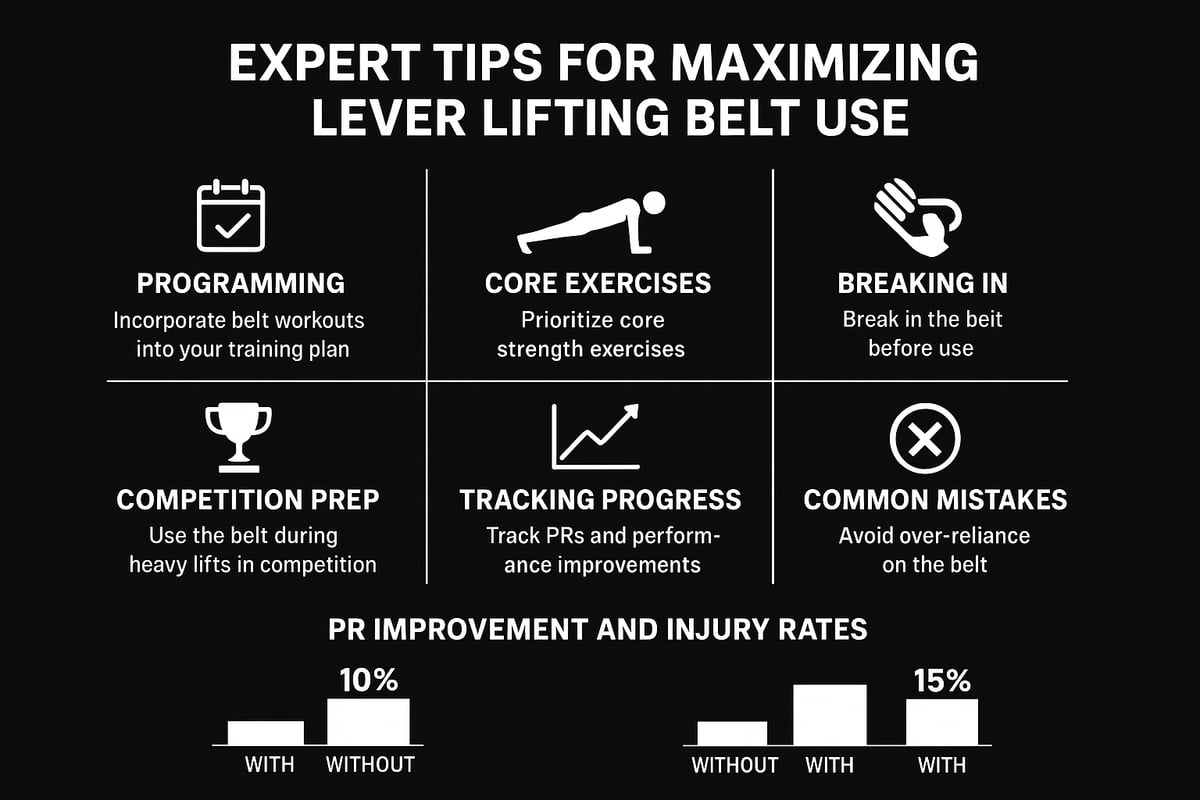
Integrate the Lever Lifting Belt Thoughtfully in Your Training
A lever lifting belt is a powerful tool, but relying on it for every set can limit your long-term gains. Plan your sessions so you use the belt during heavy compound lifts and personal record attempts, while still training beltless for lighter sets to keep your core strong. This balance helps you develop both raw strength and technical skill.
Build a Strong Foundation with Accessory Work
To maximize the benefits of your lever lifting belt, pair it with accessory exercises that target your core and back. Planks, weighted carries, and hyperextensions are excellent choices. Adding grip-focused tools, like Wrist Straps for Enhanced Grip, can further support your performance, especially when pushing heavier weights.
Break In Your Belt for Comfort and Longevity
A new lever lifting belt can feel stiff at first. To break it in, roll and flex the leather gently after each use. Wear it for short periods during warm-ups before using it for full sets. This process will help the belt mold to your body, ensuring both comfort and support.
Competition Day: Strategy and Mental Prep
On meet day, know exactly when to put on your lever lifting belt. Use it during warm-ups to find your ideal tightness, then secure it one notch tighter for PR attempts. Practice your breathing and bracing routine in training so it feels automatic under pressure. Mental rehearsal is just as important as physical preparation.
Real-World Results and Data-Driven Gains
Studies have shown that a lever lifting belt can lead to measurable improvements in squat and deadlift performance, while reducing injury risk. According to a pilot study on equipment and deadlift performance, lifters using belts and straps experienced higher bar speeds and safer lifting mechanics, supporting the case for smart belt integration.
Track Your Progress and Adjust Over Time
Keep a training log to record when and how you use your lever lifting belt. Note PRs, sets, and any discomfort. This data will help you identify trends, adjust your belt tightness, and spot opportunities to train beltless for added core development.
Mistakes to Avoid
- Using the lever lifting belt for every set, which can weaken your core over time.
- Ignoring proper bracing techniques.
- Neglecting mobility and warm-up work.
- Over-tightening, leading to discomfort or breathing issues.
- Failing to maintain or inspect your belt for wear.
Quick Reference Table: Lever Lifting Belt Success Tips
| Tip | Why It Matters |
|---|---|
| Use belt for heavy lifts/PRs | Maximizes support, not dependence |
| Train core and back regularly | Prevents weakness, boosts stability |
| Break in belt gradually | Increases comfort, reduces injury risk |
| Log usage and results | Tracks progress, informs changes |
| Maintain and inspect gear | Ensures safety, extends belt life |
With these expert strategies, your lever lifting belt becomes more than an accessory—it is a key partner in your lifting journey. Approach every session with intention, and you will see consistent progress in both your strength and safety.
Lever Lifting Belt Trends and Innovations for 2025
Looking ahead to 2025, the lever lifting belt is evolving faster than ever. Today’s lifters demand more than basic support—they want belts that blend technology, sustainability, and personal style. Let’s explore the major trends shaping the future of the lever lifting belt and how you can stay ahead of the curve.
Materials Innovation: Vegan Leather and Antimicrobial Linings
One of the biggest breakthroughs is in materials. The lever lifting belt now comes in high-quality vegan leather, making it accessible for lifters who prioritize animal-free products. Antimicrobial linings are gaining traction, helping keep belts fresher for longer and reducing odor after tough sessions.
Manufacturers are also reinforcing stitching and using multi-layered suede to boost durability. These advances mean your lever lifting belt can last through countless heavy sets, all while looking and feeling premium.
Smart Technology: Data-Driven Lifting Support
Smart technology is making its way into the gym bag. Some lever lifting belt models now feature built-in sensors that track intra-abdominal pressure, belt tightness, and even reps during your workout. This real-time feedback helps you optimize bracing and technique, leading to safer and more effective lifts.
Imagine getting an instant readout on your phone, showing how your lever lifting belt is supporting each squat or deadlift. These innovations bring a new level of precision to strength training.
Customization and Personalization: Stand Out in the Gym
Personalization is huge for 2025. Lifters can now order lever lifting belts with 3D-printed hardware, laser-engraved logos, or custom colorways. Limited edition releases and collaborations are popping up, letting you express individuality while still getting top-tier support.
If you want to check the latest styles and innovative designs, browse the Latest New Releases Collection for inspiration on how to make your lever lifting belt uniquely yours.
Sustainability and Eco Trends: Lifting with a Conscience
Environmental responsibility is influencing lever lifting belt design. Brands are introducing belts made with recycled materials, water-based dyes, and eco-friendly packaging. Some even offer recycling programs for old belts, reducing landfill waste.
Choosing a sustainable lever lifting belt lets you support both your lifts and the planet. As more lifters demand earth-conscious products, expect to see even more green innovations on the market.
Market Growth and Consumer Trends: Who’s Using Lever Belts?
The lever lifting belt is more popular than ever, with sales surging across all age groups and fitness levels. According to the Lever Belts Market Size and Trends Report, the market is projected to grow steadily through 2033, reflecting rising interest among gym-goers and athletes alike.
Women’s participation is increasing, and first-time lifters are seeking premium belts earlier in their training journeys. This shift is driving brands to offer wider sizing, bold aesthetics, and more inclusive marketing.
Future Forecasts and Industry Predictions
Industry experts predict that the lever lifting belt will keep evolving, with smart features becoming standard and customization options expanding. Expect more limited edition drops, tech integrations, and partnerships between brands and elite athletes.
To stay ahead, follow leading brands and watch for new releases every season. Being early to adopt the latest lever lifting belt innovations can give you an edge in both performance and style.
You’ve now got the inside scoop on choosing and using a lever lifting belt for your 2025 fitness goals—from fit tips to the latest innovations. If you’re ready to put these expert strategies into practice and want a belt that looks as good as it performs, why not start building your ideal setup today? At Katamu, you’ll find premium lever belts in standout designs, plus handy extras like wrist wraps and duffle bags. Investing in quality gear can make all the difference in your lifts and your confidence.
Build your setup
